A Happy and Blessed New Year Wish to each of you, our readers!
As you know, I normally hold “disclosures” until the article’s end. But in this instance, I feel a need to disclose upfront that Olive Garden has long been one of my favorite restaurants. Keep that in mind as you read this article about that chain’s owner – Darden Restaurants, Inc. (DRI).
DRI is a great reminder that an industry “favorite” can quite possibly be less than ideal as an investment – even when the corporation has accumulated countless “pluses” through the years.
First, let me catch you up on how DRI came to exist[1]:
- A 19-year old William Darden started his first restaurant in 1938 in Waycross, Georgia – “The Green Frog”;
- In 1968, he was inspired to create a (then) new concept – “Red Lobster Inns of America”.
- He chose Lakeland, Florida as the location for the first site because it was Florida’s most “interior” city and Darden wanted to test how a seafood restaurant would fare away from any coastal region.
- It became a huge hit, and within two years had three locations, with two more on the way.
- However, because Darden did not have the deep pockets needed to expand further, he sold the fledging company to General Mills Inc (GIS) in 1970. GIS retained Darden as the company manager.
- Under GIS, Darden grew, adding:
- Olive Garden (first site was Orlando, FL) in 1982;
- Two concepts that failed to survive more than a few years:
- York Steak House;
- China Coast.
- By 1995, GIS decided to spinoff the restaurant business (to concentrate on its consumer food operation)
- DRI (newly spun-off) used its independence to do the following:
- Created Bahama Breeze Caribbean Grille in 1996;
- Developed Seasons 52 in 2003 (initially only in Georgia and Florida);
- Acquired The Capital Grille and LongHorn Steakhouse restaurant chains by buying (Atlanta-based) Rare Hospitality in 2007;
- In 2011, it purchased Eddie V’s Prime Seafood and the Wildfish Seafood Grille;
- In 2012, it acquired the Yard House chain (its concept is centered upon a plethora of craft beer).
What an interesting (and shrewd) corporate evolution! It started very small[2], caught onto an intriguing concept[3], executed that concept extremely well, and generated enough positive buzz to attract a “deep-pockets buyer” (GIS) willing to expand it across the U.S.
I liken the 1970-95 period under GIS to the maturation of a human life from infancy through college graduation – with GIS footing the bill for that life’s nurture, training, protection, professional education, and graduation. Then, the parent (GIS) felt it was time to “kick the adult child out on its own” so GIS could place its full focus upon its own priorities. That “spin-off” decision was the catalyst that sent DRI on the course toward its full destiny, both literally and figuratively.
Think for a moment about the term “spin-off”… then think about what a Hammer Throw athlete does in that event (“spin”… then release… having provided powerful forward momentum).[4] That is precisely what GIS did for the living corporate entity that has become the DRI we know today!
My use of an analogy that likens GIS to a parent that supported the nascent Darden chain through its early growth toward corporate expertise and its graduation to independence is extremely germane in the context of the current “story” that surrounds DRI! Notice that at the time of the “spin-off”, the crucial, irreplaceable core of DRI consisted of two restaurant chains: Red Lobster and Olive Garden. During the past 15 months, however, the financial press has made it clear that key Wall Street firms are in agreement that Red Lobster and Olive Garden have become akin to an albatross around the corporate neck of DRI… holding the stock back from delivering full shareholder value.[5]
I’ll summarize that story for you in just a moment; but first, allow me to highlight for you some of the distinctive features found within DRI:
1) Headquartered in Orlando, FL, DRI is the world’s largest full-service restaurant entity, owning and operating over 2,100 restaurant locations (franchising locations is not part of its business model);
2) Although no other full service restaurant company has ever appeared within the FORTUNE “100 Best Companies to Work For”, DRI has appeared within that notable list for three years in a row:
a. DRI has an exceptional record of upward mobility among its employees (the total work force exceeds 2,100);
b. Consider these employee metrics (below):
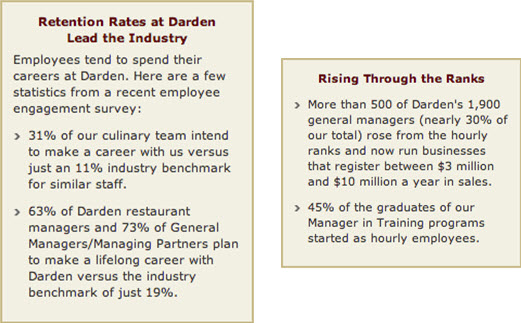
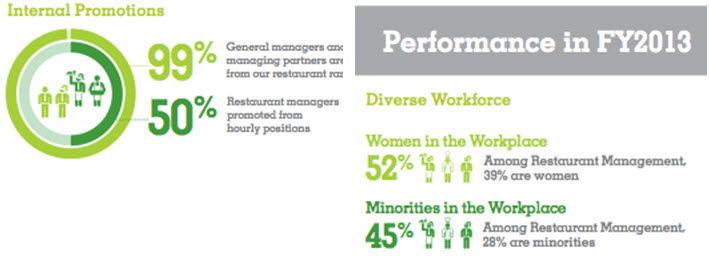 3) DRI has demonstrated impressive and steady growth since 1995 (see the spreadsheet summarizing these metrics … at the end of this article)–
3) DRI has demonstrated impressive and steady growth since 1995 (see the spreadsheet summarizing these metrics … at the end of this article)–
a. The number of locations has grown by 72%;
b. Earnings per share has grown by 929%;
c. Sales have grown by 170%;
d. Total Assets have grown by 228%.
e. According to YahooFinance.com, the market cap has grown to almost $7 billion;
i. Interestingly, shares outstanding have decreased by 18%;
ii. That is true despite a 3 for 2 stock split in 2002.
f. Stockholder Equity/Share has grown by 113%.
g. Because of its prominence in the industry, DRI is included within the S&P 500 Index.
4) From the beginning (1996) onward, DRI has paid dividends to shareholders, starting with 8 cents/share in 1996.
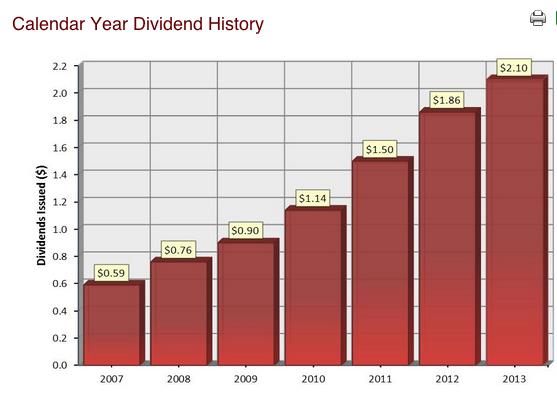 a. DRI has raised its dividend payout each of the past five years
a. DRI has raised its dividend payout each of the past five years
b. The annual payout currently stands at $0.55/quarter ($2.20/year)
c. YahooFinance.com shows the DRI yield at 4%.
d. That level exceeds the yield payout of its peers: Cracker Barrel Old Country Store (CBRL) 2.8%; Brinker International (EAT) 2.1%; and Cheesecake Factory Incorporated (CAKE) 1.2%.
5) DRI is almost universally recognized as owning two of the most widely recognized restaurant brands in the U.S.
a. Anyone who has driven across the nation on interstate highways has regularly seen Olive Garden and/or Red Lobster signs along the way!
b. Evidence of the strength of these brands is the long wait time diners usually face for a table on a Friday or Saturday night.
6) One of the metrics prominently displayed within the DRI website is the following graph… demonstrating that “Total Return” from an investment in DRI over the past six years (ie. including the beginning of the Financial Crisis) has outperformed the S&P 500 Index (dramatically):
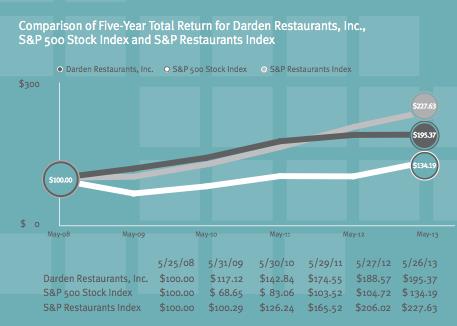 7) Our “Ecologically Aware” readers will want to know that, from the beginning, DRI has committed itself to promoting “Sustainability”.
7) Our “Ecologically Aware” readers will want to know that, from the beginning, DRI has committed itself to promoting “Sustainability”.
The company has been most widely recognized for its reduction in water usage (down over 15% since 2008):
 However, it has also set objectives related to energy use reduction and the lowering of greenhouse gas emissions (GHG):[6]
However, it has also set objectives related to energy use reduction and the lowering of greenhouse gas emissions (GHG):[6]
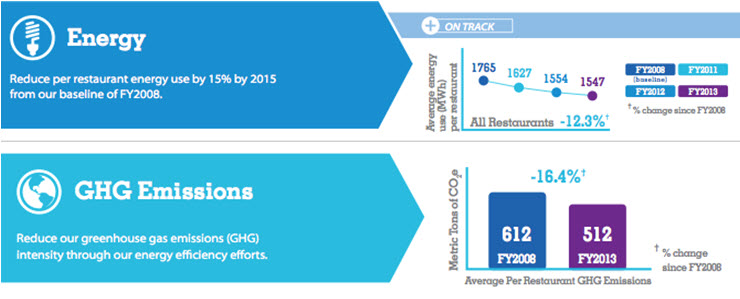 As you can see, what has appeared above is a fairly strong “bullish case” for DRI and its stock![7] But you already know (from the title and one or two earlier comments) that storm clouds have gathered over DRI and some key Wall Street players have lined up – encircling the DRI board and management much as a shark circles its chosen prey!
As you can see, what has appeared above is a fairly strong “bullish case” for DRI and its stock![7] But you already know (from the title and one or two earlier comments) that storm clouds have gathered over DRI and some key Wall Street players have lined up – encircling the DRI board and management much as a shark circles its chosen prey!
So what are the current weaknesses of DRI that have drawn such intense and energized interest within Wall Street circles?[7] In what ways is DRI vulnerable?
In what ways is DRI vulnerable?
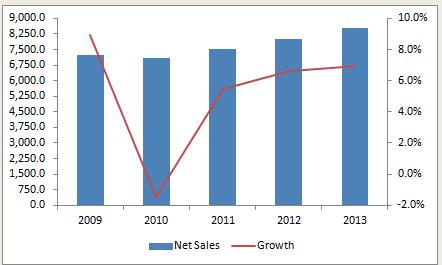 Let’s start with some graphs, since “a picture is worth a thousand words”. The standard business strategy of DRI has been to grow through expanding its store base, while leveraging steadily increasing “average check per guest” figures and continuing cost management and menu optimization. DRI’s success with this strategy was demonstrated in the metrics I itemized earlier! However, look at trends during the most recent few years[8]:
Let’s start with some graphs, since “a picture is worth a thousand words”. The standard business strategy of DRI has been to grow through expanding its store base, while leveraging steadily increasing “average check per guest” figures and continuing cost management and menu optimization. DRI’s success with this strategy was demonstrated in the metrics I itemized earlier! However, look at trends during the most recent few years[8]:
1) Growth vis-à-vis Net Sales (see the image above). You can see that store location growth has not resulted in a commensurate increase in sales!
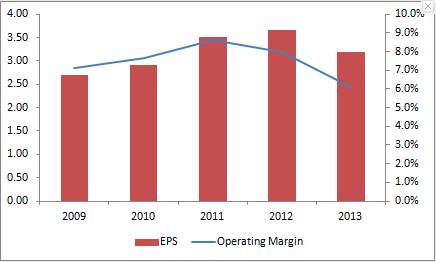 2) We can see to the left that operating margins have been under pressure.
2) We can see to the left that operating margins have been under pressure.
3) The “Average Check Per Guest” data below demonstrates how stagnate the average revenue per guest has been for the three biggest DRI brands.

4) Finally, given all of the above, the following graph should be absolutely no surprise. This graph shows an extremely troubling trend in DRI’s ability to cover its fixed expenses – costs it is obligated to pay no matter what! The current ratio is actually lower than it was in 2009!
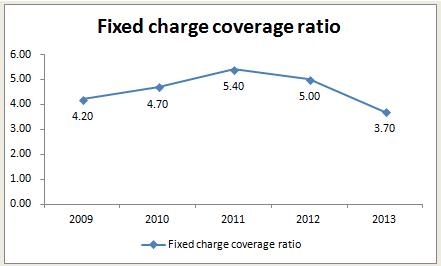 Now that you have grasped the operational/financial stress within which DRI is operating, what could account for these stresses? There are a number of factors at work here, among which are the following:
Now that you have grasped the operational/financial stress within which DRI is operating, what could account for these stresses? There are a number of factors at work here, among which are the following:
1) Industry-wide, full service restaurants are moving through a period of low revenue growth—
a. Casual dining of the “less than full service” variety has been growing, including competitive options such as Panera Bread (PNRA) and Chipotle Mexican Grill (CMG).
b. New full service options have grown popular, including Maggiano’s (chain within EAT) and Carrabas (part of Bloomin’ Brands Inc. (BLMN)).
c. North American Casual Restaurant Index data (from Bloomberg) shows a growth rate (since June 2009) of 164%, versus just 55% at DRI.
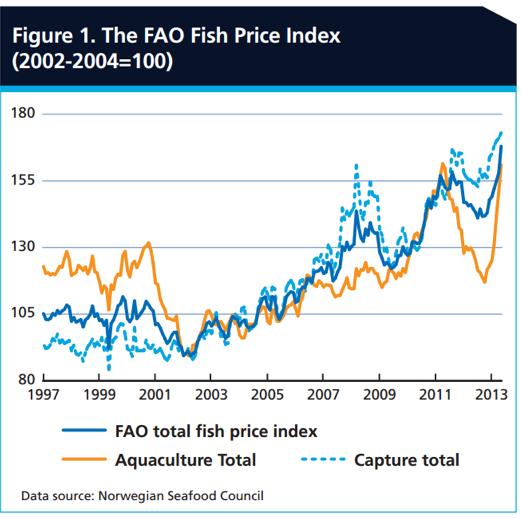 2) Dietary and Societal Changes—
2) Dietary and Societal Changes—
a. Many Americans have adopted a “Low Carb” diet. DRI’s existing menus at Olive Garden and Red Lobster do not cater to such folks.
b. There is growing consumer demand for smaller portions and healthier food choices.
c. More and more people perceive that they cannot afford to take the time for “sit down” meals… they are “on the go” and “in a hurry”.
3) Seafood prices have ballooned (see the FAO Fish Price Index graph above) because of increasing demand by consumers in emerging markets (China in particular) for “high end” fish items! That has brought stress to both the customer traffic levels and bottom line at Red Lobster!
Just consider these metrics from the most recent (November 2013) DRI financial report:
1) Same store sales at Red Lobster were down by 4.5%; even worse, foot traffic metrics for the quarter (compared with one year earlier) were down (September, October, November) by 5.8%, 9.9%, and 7.3% (respectively);
2) Same store sales at Olive Garden were down by 0.6%;
3) In sharp contrast, same store sales at Longhorn Steakhouse were up by 5.0%!
4) And demonstrating an even greater divergence in performance, the “Specialty Restaurant Group” (all the other brands) reported that sales for the quarter were up by 20.6%, including same store sales hikes of 6.7% at The Capital Grille, 6.2% at Bahama Breeze, and 5.7% at Eddie V’s!
If you allow me to summarize the above in far too simplistic a fashion, here is my interpretation:
1) DRI’s historic strength, Olive Garden and Red Lobster, has now become its biggest point of vulnerability.
a. See the slides below from Barington Capital’s investor presentation (December 2013);
b. Olive Garden and Red Lobster are firmly stuck at the bottom of comparative same store sales growth metrics;
2) This under performance is severely aggravated by the huge share of DRI sales/profits accounted for through these two huge chains.
a. Olive Garden alone accounts for 40% of DRI revenue!
3) The next slide demonstrates the extent to which the two biggest DRI chains significantly underperform vis-à-vis the other DRI chains, as well as DRI competitors:
The market has already recognized these factors, since Darden's enterprise value (in December) was equal to just 7.4 times its trailing 12-month earnings (before interest, taxes, depreciation, and amortization). According to Bloomberg, this metric is lower than an amazing 86% of casual restaurants in North America![10]
We all know how “patient” Wall Street is when it comes to performance, growth, and “meeting expectations”! So it is no surprise that Wall Street analysts have been alarmists, while DRI management has been trying to foster a more tempered view of this situation.
For example, Bryan Elliott, a Raymond James analyst in Atlanta, is reported as having opined regarding Red Lobster: “This quarter was very bad. Its customer base is slowly dissipating.” A Morningstar analyst, R.J. Hottovy, has identified DRI marketing efforts as having been lackluster, attributing that to “ineffective promotional strategies and a lack of new menu innovations.”
Meanwhile, the DRI CEO, Clarence Otis, has identified general industry challenges and noted the importance of DRI’s efforts to more effectively help consumers to see DRI brands as affordable: “Our industry is in a period of significant change, with relatively low levels of consumer demand in each of the past several years for restaurants generally, and for casual dining in particular…. We began to match competitive promotional intensity around affordability, which involved being more aggressive with the pricing of our offers.” (That echoes what we identified earlier as increased competitive pressures!)
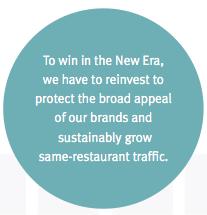 It is worth noting that DRI management, recognizing that Wall Street has not been pleased with it and the sharks are circling, has made an effort to reassure investors that it recognizes that the competitive landscape will require that it makes changes. In its most recent annual report (May 2013) it identifies the current economic environment for restaurants as “the New Era”! In fact, the theme throughout the report was tied to that “New Era”.[11]
It is worth noting that DRI management, recognizing that Wall Street has not been pleased with it and the sharks are circling, has made an effort to reassure investors that it recognizes that the competitive landscape will require that it makes changes. In its most recent annual report (May 2013) it identifies the current economic environment for restaurants as “the New Era”! In fact, the theme throughout the report was tied to that “New Era”.[11]
In Part II, we will identify the two activist investors that are pressuring DRI to adopt an extremely ambitious restructuring plan. In addition, we will highlight the essential features of that plan to restructure – a plan that includes multiple spin-offs.
Submitted by Thomas Petty MBA CFP
[1] Its story was certainly new to me!
[2] No one can convince me that “The Green Frog” could ever have gone “national”!!
[3] A non-coastal seafood restaurant.
[4] For a video, see https://myspace.com/winston174/video/historic-hammer-throw/11394854
[5] The “albatross” image refers to lines from the poem The Rime of the Ancient Mariner by Samuel Taylor Coleridge, in which the mariner, who killed an albatross, is obliged to carry the burden of that bird around his neck as a punishment for (and reminder of) his action.
[6] For the full “Sustainability Report”, see http://www.darden.com/sustainability/downloads/2013-performance-summary.pdf
[7] By the way, the Market Tamer Algorithm picked DRI for December 31st as a bullish stock – which prompted me to do all this research.
[8] My cynical view is, in the grand tradition of the movies “Wall Street”, “Wall Street: Money Never Sleeps”, and the current “The Wolf of Wall Street”, several Wall Street firms look at DRI and see a venerable company that has become vulnerable. They seem to be convinced that “easy money” can be had – if they force a major restructuring and spin-off (actually, two spin-offs). Therefore, they resemble the predatory shark!
[9] These graphs are from DRI SEC filings and other reports.
[10] Enterprise Value was $9.5 billion.
[11] I will give management credit for realizing it had to do something. However, the theme “New Era” is, in my opinion, a pretty lame response to all the challenges it faces.
Related Posts
Also on Market Tamer…
Follow Us on Facebook

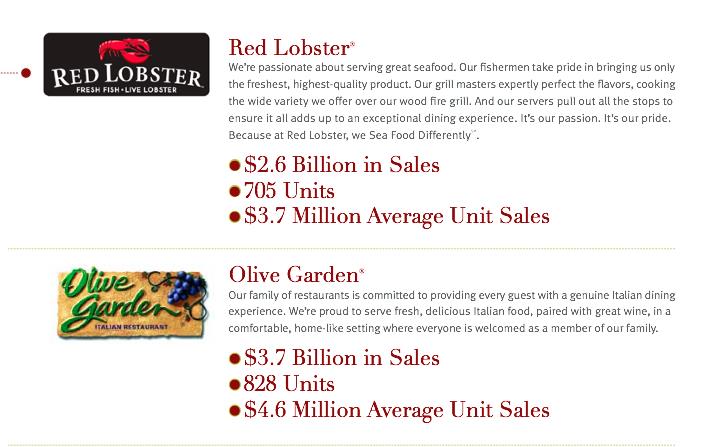
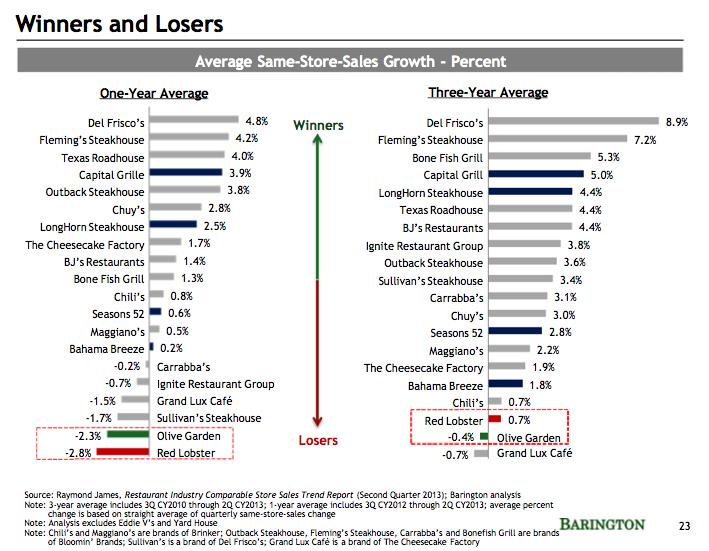
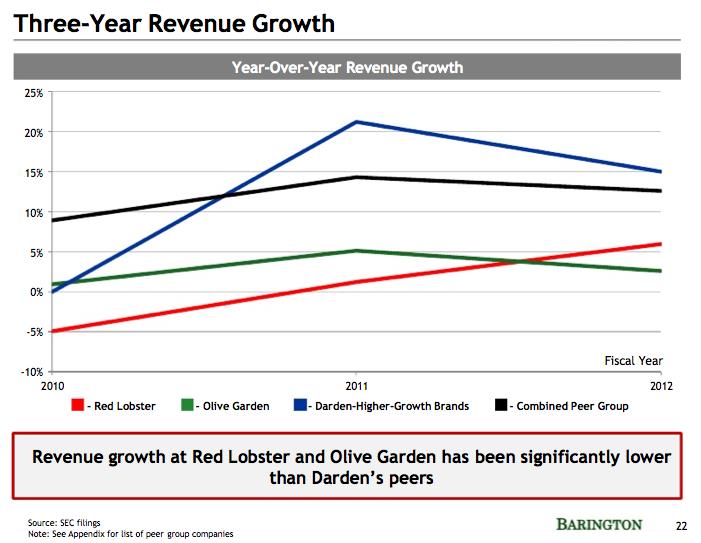
 Why Roche Holding, Eli Lilly, and AstraZeneca Stocks Dropped Today
Why Roche Holding, Eli Lilly, and AstraZeneca Stocks Dropped Today

